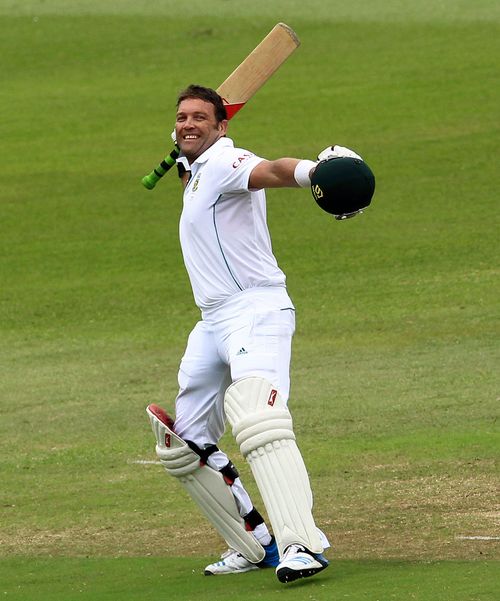
Jacques Kallis, the greatest cricketer South Africa have produced

Jacques Kallis signs off his test career with a century
The year 2013 saw one of the greatest all-rounders to have graced the game of cricket in Jacques Kallis calling it a day. Kallis announced his retirement from Test cricket after the 2nd Test match against India in Durban, ending an illustrious test career that lasted close to 2 decades. He has stated his intention to continue playing in the shorter formats, in the hope that he can win that elusive World Cup when the tournament is played in Australia and New Zealand next year.
It is worth pausing for a moment and just looking at the incredulous numbers Kallis has racked up over his long career. He amassed 13,289 runs in 166 test matches at a stupendous batting average of 55.37 with 58 half-centuries and 45 centuries. He is the third highest run-getter in the history of test cricket behind Sachin Tendulkar and Ricky Ponting. His numbers as a batsman alone are enough to put Kallis in the pantheon of the greatest cricketers of all time but when you consider the 292 wickets and 200 catches he has taken to go along with the truckload of runs, you know that such cricketers seldom come by.
Yet, his career wasn’t supposed to pan out the way it has, if you go by the start he had to international cricket. Kallis, despite bristling with talent ever since his teenage days, didn’t start off his career with a bang. His introduction to test cricket against England and subsequently Australia as a 20 year old was a baptism of fire. His scores in his first 7 innings read 1, 7, 6, 39, 0, 2 and 2 with his first half-century taking him 6 matches and 10 innings, against Pakistan in Rawalpindi.
It took him a bit more than two years to register his first test century which came against the might of Australia at the MCG in a match-saving innings of 101. It was his first substantial knock for South Africa and would have without doubt given him confidence that he belonged at the international level. The confidence that he derived from that performance at the MCG didn’t translate into big scores immediately though, as he averaged 31 and made just two hundreds in his first 22 tests.
His moderate beginning didn’t justify the talent he oozed right from the very outset. The South African selectors knowing that it was just a matter of time before he got going at the international level stuck by him and were duly rewarded. The turning point was probably the New Year Test match in 1999 against West Indies in Cape Town where he played a pivotal role in South Africa’s victory by making 110 and 88* against Curtly Ambrose & co. in the match. That kick-started a period of prolonged success with the bat and he never really looked back after that.
Kallis was a much more superior batsman than bowler without question but the role he played with the ball for the team cannot be underestimated. With him being a skilled top-order batsman and a shrewd bowler at the same time, he gave South Africa the envious luxury of fielding a 5-man bowling attack without having to compromise on their batting depth.
He never shirked his responsibility with the ball and was willing to bowl 15-20 overs a day for the team despite it taking a heavy toll on his body especially as he aged. He not only bowled his fair share of overs, thus easing the workload of the other bowlers but also had the uncanny knack of breaking a partnership between well-set batsmen.
The one criticism of Kallis for much of his career which also explains why he is perhaps not as celebrated as his contemporaries was the pace at which he batted. His game was largely based on self-preservation and endurance, waiting for the bowler to come to him rather than the other way round. He trusted his methods and stuck to his guns despite being ridiculed, sometimes unfairly, for his slow scoring rate and perceived selfishness.
Kallis towards the latter part of his career showed that he has got another side to his batting and that he is capable of going up a few gears when necessary. He struggled in the 1st season of the IPL and got a lot of criticism for his performances. He was deemed unsuitable for the shortest version of the game but that only made him more determined to improve and the results were quick to arrive. He started showing a lot more positivity in his batting and that translated to test cricket too and made him even more of a force. His strike-rate in tests in the period coinciding with the IPL is 50.62 as compared to the low 40s at the start.
| Period | Tests | Runs | Average | Strike-rate | 100s/50s |
| Till Dec 1998 | 22 | 1019 | 30.87 | 36.62 | 2/5 |
| Jan 1999 to Dec 2007 | 90 | 8263 | 65.06 | 44.96 | 27/41 |
| Jan 2008 to Feb 2009 | 17 | 778 | 31.12 | 45.76 | 1/4 |
| Mar 2009 to Dec 2013 | 37 | 3229 | 46.83 | 50.62 | 15/8 |
| Career | 166 | 13289 | 55.37 | 45.97 | 45/58 |
Sir Garfield Sobers has been the undisputed no.1 all-rounder for all these years but Kallis has challenged that notion in recent years with his imposing numbers and remarkable consistency over such a long period of time, not just in test cricket but in ODI cricket too.
Batting
| Matches | Runs | Average | 100s/50s | |
| Jacques Kallis | 166 | 13289 | 55.37 | 45/58 |
| Gary Sobers | 93 | 8032 | 57.78 | 26/30 |
Bowling
| Matches | Wickets | Average | Strike-rate | Overs/test | |
| Jacques Kallis | 166 | 292 | 32.60 | 69.2 | 20 |
| Gary Sobers | 93 | 235 | 34.03 | 91.9 | 39 |
Old-timers will shudder at even the thought of comparing anyone with Sobers who in their eyes stands head and shoulders above the rest. Sobers, due to his flamboyance and ability to win games single-handedly with both bat and ball is ahead of the rest and rightly no.1 but interestingly, assuming that Sobers had played 166 test matches, the same as Kallis and managed to retain his high standards, their numbers would not be too dissimilar.
| RUNS | 100S | WKTS | 5-FOR | CATCHES | |
| SOBERS | 14337 | 46 | 419 | 11 | 195 |
| KALLIS | 13289 | 45 | 292 | 5 | 200 |
The stats present an interesting comparison but we as fans, have to simply cherish the fact that we have been fortunate to have had such greats grace this game of ours.
Kallis, despite his seemingly serious demeanour, also has a humorous side to him which is not all that well known. For example, when South Africa conceded 434 runs against Australia in that historic ODI game at Johannesburg in 2006, the entire team was downbeat during the break and needed cheering up. Kallis realizing the need to ease the tension came up with a tongue-in-cheek comment along the lines of, “Well guys, the bowlers have done the job. They’re 10 runs short of what they should have got. Let’s go and get it,” and the rest as they say is history.
Kallis has been the backbone of the team for the last decade or so and has always come up with big contributions at crucial junctures. In spite of his numerous accolades in the game, he has always been content at being in the background and letting the other guys be in the limelight. He has left a huge void in the South African team both on and off the field with his departure and that void can never be plugged. It’s not just the South African team but the entire cricketing world that is going to miss him. He was truly one of a kind.